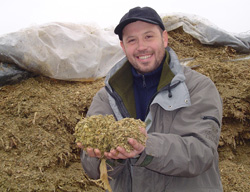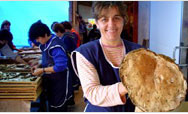You are here » Home » Telling Our Story
Case Study
Improved farming techniques double crop and milk yields
Better Feed Brings More Milk

| |
Photo: Chemonics International/Milazim Makolli
|
|
Driton Krasniqi with newly produced feed, at Rudina Farm in Prizren, Kosovo.
“For the first time ever, I managed to produce 1,600 tons of high quality [feed], averaging 48 tons per hectare. It cost me only 19,200 euros, instead of 48,000 euros if I were to buy it,” said Aruq Krasniqi of the Rudina farm, Prizren.
|
Challenge
Dairy cows in Kosovo have long produced low yields of milk. To increase their production, dairy farmers needed to start growing more feed, introducing better corn and alfalfa hybrids, and implementing new growing techniques – all while keeping costs low. But without first-hand experience in these techniques, many dairy farmers were skeptical about the benefits of this approach.
Initiative
USAID launched an on-farm teaching project to demonstrate the effectiveness of these techniques. Working with commercial dairy farmers, USAID created on-farm demonstration plots, where farmers applied new growing techniques for feed. They applied proper fertilization, grew better corn and alfalfa hybrids for animal feed, and cut the crops at their peak, when nutrient values are highest. The program also brought dairy farmers to the U.S. for a training program in management techniques to improve milk quality. Finally, the program facilitated linkages between dairy farmers and dairy processors. Based on results gathered during crop feed trials, USAID recommended new hybrids with high production potential and new fertilizer formulations most appropriate for the local environment.
Results
The farmers were impressed with the results. Today, 28 percent of planted fields in Kosovo are growing the new hybrids. Their average yield is 6.2 tons/hectare and 46 tons/hectare of corn and silage compared with non-hybrid yields of 3.8 and 16. Milk production is up by two liters per cow, per day on one demonstration farm, Rudina, where cows are gaining one pound of weight per day. Rudina’s owner, Aruq Krasniqi, calculates that the new techniques are increasing the farm’s income by about one euro per cow, per day. With over 100 milking cows, the farm’s revenue has jumped by $3,500 per month. Rudina produces 600,000 liters of milk annually. A number of other farms have now applied the new techniques and adopted USAID’s recommendations. They have cut feed expenses in half, and are doubling and tripling the volume of milk produced.
Print-friendly version of this page (527kb - PDF)
Click here for high-res photo
Back to Top ^ | 

